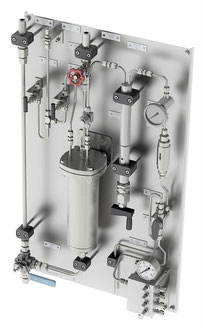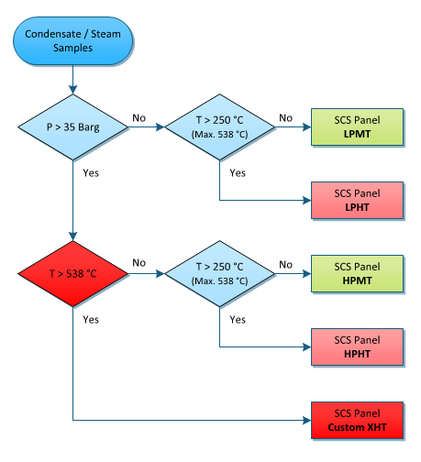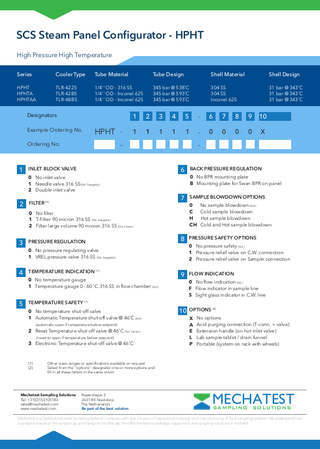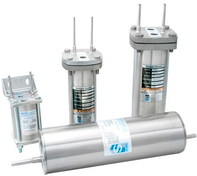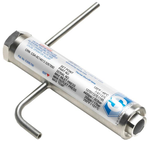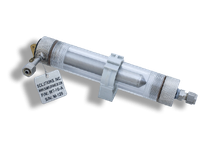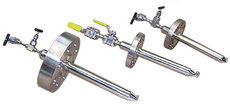SWAS components
Steam sampling and analysis components
Mechatest is well known for it’s excellent quality steam and water sampling and analysis solutions built as per ASME PTC 19.11 and VGB S-006.
The Steam and Water Analysis Systems (SWAS) are designed with worlds best-in-class instrumentation parts to keep the reability of your water steam analysis safe at all times and to protect your power plant from corrosion and scaling.
As a result, you save maintenance costs, minimize downtime and prolong the operational life for your plant.
After selecting the analysers and designing the sample systems it is very important to choose the environment for the complete system.
- Built as per standard VGB/DGRL and guidance ASME PTC 19.11 Steam and Water Sampling, Conditioning, and Analysis in the Power Cycle.
- Compact design with best selection of top of the world fabricate components
- Efficient temperature cooling with Sentry sample coolers, pressure reduction with Sentry VREL and flow control
- Grab sample capability
- Including Swan Back Pressure Regulator BPR for constant pressure and sample flow for up to 4 water analyzer applications
- Custom options are available to fit your needs
- Manufactured by Mechatest Sampling Solutions.
As an independent System Integrator our main activities are the complete design, engineering, procurement, assembly and integration of steam and water sampling, conditioning, and analysis systems for the power cycle industry, we design accordingly to VGB/DGRL and ASME PTC 19.11 which discuss the methods and instrumentation for testing boiler make-up and feedwater, steam, and condensate in relation to performance testing.
Steam and Water Analysis Systems - SWAS analyser racks and containers. Steam Sample Conditioning and Collection. Sampling solutions for steam & water sampling. Sample Conditioning Panels built as per standard ASME PTC 19.11 and VGB/DGRL. For proper conditioning of your steam and water samples. Steam apllications Demi Water, Feedwater, Condensate, Boiler Water, LP Drum Water, LP/HP Steam, Life Steam, Main Steam Demi Water, Feedwater, Condensate, Boiler Water, LP Drum Water, LP/HP Steam, Life Steam, Main Steam for power stations. Representative steam samples, Contamination free process and Custom build solutions. Control Your Steam Quality, increase lifetime of your steam applications, prevent corrosion in boilers and pipelines.
- Reliable / stable measurement
- A good working environment for monitoring and maintenance
- Lower maintenance costs
- Longer lifespan of the equipment, etc.
- In a lot of cases a “walk-in” shelter is a very good and durable solution.
- Stack Emission Monitoring - CEMS Analyser Systems, Analysis of Hydrocarbons, O2, CO, CO2, NO, Nox, SO2, H2O
- Custody-Transfer of Natural Gas, Analysis of BTU, N2 to C6+, H2S, Dewpoint for offshore and pipeline metering skids
- Ultra-Low-Sulfur Diesel, Analysis of Sulfur in diesel fuel for most highway vehicles
- Quality Analyzer systems, Perfectly tailored to your individual requirements
- Steam and Water Analysis System (SWAS), Analysis of pH, Conductivity, Silica, Sodium, Dissolved Oxygen, Phosphate, Chlorides, TOC for power stations
- etc.
- ASTM D 4057
- ASTM D1265-05
- NACE MR0175 or MR0103
Samples must be taken from locations that are representative of the steam or water source, treatment plant, storage facilities, distribution network, points at which water is delivered to the consumer, and points of use. In selecting sampling points, each locality should be considered individually; however, the following general criteria are usually applicable:
Sampling points should be selected such that the samples taken are representative of the different sources from which water is obtained by the public or enters the system.
These points should include those that yield samples representative of the conditions at the most unfavourable sources or places in the supply system, particularly points of possible
contamination such as unprotected sources, loops, reservoirs, low-pressure zones, ends of the system, etc.
Sampling points should be uniformly distributed throughout a piped distribution system, taking population distribution into account; the number of sampling points should be proportional to the
number of links or branches.
The points chosen should generally yield samples that are representative of the system as a whole and of its main components.
Sampling points should be located in such a way that water can be sampled from reserve tanks and reservoirs, etc.
In systems with more than one water source, the locations of the sampling points should take account of the number of inhabitants served by each source.
There should be at least one sampling point directly after the clean-water outlet from each treatment plant.
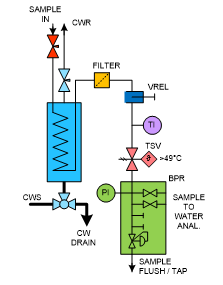
Sample Conditioning Panels are designed for proper conditioning of your steam and water samples. We take care from sample tap to sampling conditioning and analysis.
Mechatest designed a range of standard sample conditioning panels for steam and water sampling purposes, the conditioning systems has the main function to cooling down the high sample temperature, to regulate the temperature, flow and pressure of the sample. This kind of sampling panels are mostly used in combination with water analyser equipment for analysis on chemical parameters like conductivity, pH, dissolved Oxygen, Silica, Sodium etc.
The panels are designed with best quality products for safe operation and representative sample at the desired pressure and temperature.
Mechatest steam sampling panels are standard designs but can be configured by yourself, the following basic components are a part of the solution;
- Sample inlet shutt-off valve
- Sample hot blowdown valve
- Sample cooler
- Cooling water inlet and outlet valve
- Particle filter
- Pressure reducing valve
- Temperature indicator
- Temperature protection
- Back pressure control
Options are:
- Magnetic filter
- Cold blowdown valve
- Sightglass flow indicator in cooling water
- Flowmeter with alarm for the sample streams to the analysers
- Safety relief devices in the sample line and/or cooling water
- Double block inlet valves
- Two sample streams sharing
- Grab sampling
- Acid purging connection
- Extension handles to release high temperature
Steam Sampling Components
Steam Sample Coolers
- Single Helical Tube Sample Cooler
- Compact, high efficiency sample coolers for cooling high temperature/high pressure liquid or gas samples
- Temperature ratings to 593°C at 345 barg (1100°F at 5000 psig)
- Models available for ultra-supercritical power plants with temperature ratings to 621°C at 356 barg (1150°F at 5175 psig)
- Exotic materials such as titanium, Inconel® and Hastelloy® on the tube side, and Monel®, cupronickel, and stainless steel on the shell side are available
- Highest efficiency sample cooler commercially available
- Various configurations available to meet EPRI/ASTM/ASME sampling guidelines
- Many models are available with ASME section VIII code stamp, CE or CRN registrations
- No dead spots or crevices
- Sample flow rates up to 5.7 liters per minute (1.5 gallons per minute GPM); for higher flow rates see
Steam Pressure Reducing Valve Sentry VREL
- High Pressure Sample Flow Control Valve
- The VREL® is an adjustable sample pressure reducerfor sample pressures above 34.5 barg (500 psig) according to the Annual Book of ASTM Standards, ASTM Designation D3370. A precisely machined tapered rod assembly moves inside precision holes within the barrel of the VREL®. Pressure drop is a function of the length of the rods inserted into the barrel.
Sentry Thermal Shutoff Valve (with reset button)
- Shuts down high temperature sample in less than 5 seconds.
- Need to reset by push button after sample is cooling down
- Protect operators, analyzers and sampling components from high temperature liquids with a Sentry Thermal Shutoff Valve. The sensor/actuator is directly exposed to the sample, providing quick reaction time. Economical and highly reliable replacement for solenoid shutoff valve and temperature controller.
- Suitable for system pressures up to 4400 psi (303 bar)
- Totally mechanical design requires no electricity, air, or hydraulics
- Optional dry contact for remote indication
- Standard trip temperature is 120ºF (49ºC) with other temperatures available
- 316 Stainless Steel construction
Thermal Shutoff Valve (automatic)
- Thermal Shutoff Valve (automatic)
- ThermOmegaTech
- Protects expensive and delicate sample analyzers
- Automatically resets when sample cools
- No outside power required
- Superior value vs. more expensive electric valves
Design Features
- Self-operating thermal actuator controls flow based on fluid temperature
- Operating temperatures unaffected by variable inlet pressures
- Wide choice of setpoints available
- Ram-type plug provides tight shutoff
- Corrosion resistant: all stainless steel construction
Typical Applications
- Excessively hot samples can cause damage to expensive and sensitive hardware and electronics. For process analyzers and similar instrumentation, it is important to assure that the process samples fluids are always below the maximum allowable temperature for such instruments. Sample coolers are commonly used to reduce sample temperatures to the acceptable limits. In the event of a loss of cooling fluid to the sample cooler, or if the desired sample temperature is exceeded for any reason, the HST valve will close to prevent equipment damage. HST valves are covered with our standard 36 month prorated warranty.
Operation
- The HST (High Sample Temperature) safety shutoff valve is used to sense the sample temperature after the sample cooler. The sample passes through this normally open valve whenever the sample temperature is below the valve setpoint. If the sample temperature exceeds the valve setpoint, the HST closes to protect expensive and delicate analyzers and other instruments from overtemperature damage. When the HST cools below the setpoint, it will automatically reset open again.

Refillable Cation Exchange Resin Columns
- Minimize "dead volume" assuring representative samples
- Three models* (RC-100, RC-200 and RC-400) meet your specific requirements, withstanding the demands of power plants
- Column(s) provide optimum fluid velocity with increased resin efficiency
- Color-changing resin gives quick visual indication of resin depletion level
- Twist-off cap for easy resin refill with available pre-sized Sentry resin refill packets
- No PVC; wetted materials will not leach chlorides or plasticizers
Magnetic Trap Filter
- Magnetic Trap is effective in removing magnetite and other iron particles from samples. It is easy and intuitive to clean and service.
- The magnet inserts into the "dry well" and does not contact the sample fluid. Magnetite sticks on the wetted side of the drywell. To clean the trap simply divert the sample outlet to drain and remove the magcore from the drywell to flush the magnetite and debris from the trap.
- The cleaning process requires no disassembly of the trap or exposure of the sample to atmosphere. This is especially beneficial when it is used to remove iron oxides and other magnetic material from a sample that feeds Dissolved Oxygen analysers or other sensitive instruments.
Technical Details:
- Rating: 13.8 bar @ 24°C
- Max. Temperature: 65°C
- Dead Volume: 30 ml
Isokinetic Sampling Probes For Steam Applications
- Isokinetic Sampling Nozzles (Probes)
-
Sampling gases and liquids for on-line and grab sample chemical analysis can be a major source of errors. Up to several orders of magnitude concentration changes of dissolved and suspended impurities have been observed when sample withdrawal, cooling, or transport are not properly performed. Multi-port Steam Sampling Nozzles (Probes) are rarely used because of their complexity, cost, non-isokinetic characteristics, and problems with use in large pipes and they are no longer a part of the ASTM D1066 standard.
A more appropriate and functional design was developed and the design and performance of these nozzles was verified in the Electric Power Research Institute (EPRI) research project RP2712-8. This design was then included in ASTM D1066, "Standard Practice for Sampling Steam". Additional information about the need for isokinetic sampling and the proper design and operation of a sampling system can be found in a technical article entiled "Sampling Savvy"
- ASME PTC 19.11 The specification requires a "isokinetic sample nozzle" for representative sampling of the specific two-phase saturated steam flow via sample ports drilled in the side of the nozzle facing the steam flow.
-
Recommended ONLY for saturated steam in steam boiler and power plants, for superheated steam (only if particulates are
measured), isokinetic sampling is normally not required for water samples.
Click here and see our standard sample probes for non-isokinetic sampling.
- These nozzles meet also the requirements of ASTM Standards D1066 and D3370.
- The nozzles extract a representative isokinetic sample from a flow region removed from the pipe surface and at the average flow velocity of the sample fluid.
- This arrangement results in the withdrawal of the sample with representative concentrations of dissolved, suspended, and volatile constituents. Other applications include oil in water, water in oil, propant in oil, and sand in oil.
- An appropriate nozzle (probe) is designed for the desired sample flow and typical conditions of the sample fluid. When the flow velocity through the pipe changes, sample flow should be adjusted to maintain isokinetic sampling.
- Each Nozzle (probe) is designed with considerations of vortex shedding, resonance, vibration, erosion, and strength of the attachment to the pipe.
The nozzles extract a representative isokinetic sample from a flow region removed from the pipe surface and at the average flow velocity of the sample fluid. This arrangement results in the withdrawal of the sample with representative concentrations of dissolved, suspended, and volatile constituents.
An appropriate nozzle (probe) is designed for the desired sample flow and typical conditions of the sample fluid. When the flow velocity through the pipe changes, sample flow should be adjusted to maintain isokinetic sampling.
For superheated steam applications, it is not recommended to install the Nozzle in locations where the steam temperature is not at least 100F above the saturation temperature.
It is not recommended to install the Nozzle immediately after desuperheaters, in locations where there are large temperature changes, or where there is high carry-over of sodium hydroxide. Where these conditions exist, there should be more frequent inspection of the Nozzle, Nozzle attachment, valves, and welded tubing up to the primary cooler. If installed downstream of desuperheating sprays, the Nozzle location should be far enough downstream where complete mixing has occurred.
The preferred location for the installation of the Nozzle is in long vertical sections of the pipe, away from all flow disturbances (bends, valves, etc.). Ideally, the Nozzle should be at least 35 pipe internal diameters downstream and 4 pipe diameters upstream of any flow disturbances. If this is not possible, place the Nozzle in such a position that the ratio of its distance from the upstream disturbance to the downstream disturbance is about 9:1. If a long vertical section of pipe is not available, the Nozzle may be installed in a long horizontal section in the 10 to 2 o=clock position.
THE NOZZLE OPENING SHOULD FACE UPSTREAM THE SAMPLE PROCESS FLOW.
At the isokinetic sampling rate, the size of the condensed sample line after the cooler should be selected to obtain a minimum flow velocity of 5 to 6 ft/sec (turbulent flow) in the sampling line. This will reduce the possibility of impurity deposition in the sampling line. Typically the required tube size after the primary sample cooler is ¼ inch OD, 0.049 inch wall thickness 316 SS tube.
There should be at least 6 hours of isokinetic sample flow to stabilize the sampling system before taking a sample for analysis. Continuous flow is preferred.
Source reference: Jonas, Inc.

Be part of the best solution, it all starts with you!
We make sampling solutions helping to protect the environment now and for future generations, together we can make a difference.
| Doedijns - Mechatest Sampling Solutions | Vydraulics Group | Vremac | Sypack | |
| Bleiswijkseweg 51 | Telephone & Email | Hydropack | Koppen & Lethem | |
| 2712 PB Zoetermeer | +31(0)88 091 2811 | Vapo | GDM | |
| The Netherlands | sales.mechatest@vydraulics.com |




















